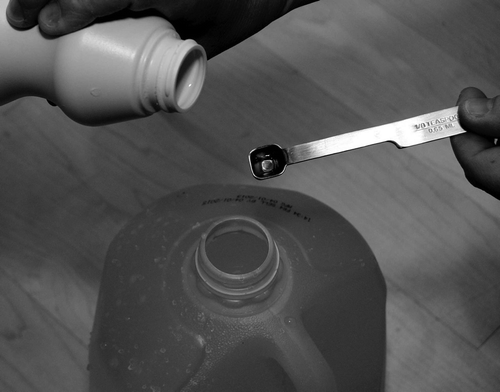Researchers question emergency water treatment guidelines

The Environmental Protection Agency's (EPA's) recommendations for treating water after a natural disaster or other emergencies call for more chlorine bleach than is necessary to kill disease-causing pathogens and are often impractical to carry out, a new study has found. The authors of the report, which appears in the ACS journal Environmental Science & Technology, suggest that the agency review and revise its guidelines.
Daniele Lantagne, who was at the Centers for Disease Control and Prevention (CDC) at the time of the study and is now at Tufts University, and colleagues note that after natural disasters such as floods, clean water can be scarce. To prevent the spread of water-borne illnesses, the EPA currently recommends "bottle, boil, bleach" in case of a water emergency. That is, people should turn to bottled water as a first resort. If that's not an option, then they should boil available water to disinfect it. As a last resort, they should add "1/8 teaspoon (or 8 drops) of regular, unscented, liquid household bleach for each gallon of water." But, as the researchers point out, 1/8 of a teaspoon is not the same as 8 drops. And both amounts are higher than CDC and World Health Organization recommendations. To further evaluate the guidelines, the team tested different bleach treatment levels at six households around the country using water from various sources.
They found that the range of EPA-recommended doses (8 drops to 1/8 of a teaspoon) were higher than necessary to kill disease-causing pathogens in the samples. In a related project, they reported that even if the guideline were lowered, many people they surveyed would not be able to carry it out. None had the right kind of bleach in the house, and few had the correct measuring devices. The researchers recommend a revision of EPA guidelines and more research into more practical water treatment products.
More information: "Emergency Water Treatment with Bleach in the United States: The Need to Revise EPA Recommendations" Environ. Sci. Technol., Article ASAP. DOI: 10.1021/es405357y
Abstract
During emergencies in the United States, the Environmental Protection Agency (EPA) currently recommends using bottled water, or boiling or treating water by adding 1/8 teaspoon (or 8 drops) of bleach to 1 gal of water. This bleach recommendation is internally inconsistent, a relatively high chlorine dose (5.55–8.67 mg/L), and unsupported by evidence. In this study, bleach was added in three different dosages to six waters available to emergency-affected populations in each of six states; free chlorine residual (FCR) and Escherichia coli/total coliforms were measured 1–24 h after treatment. Data were analyzed using four efficacy criteria. Results indicated the dosages in the current EPA recommendation are unnecessarily high to ensure (1) maintenance of FCR for 24 h after treatment, (2) absence of E. coli/total coliforms, and (3) establishment of a CT-factor sufficient to inactivate Giardia lamblia and enteric viruses 1 h after treatment. Additionally, emergency-prone populations did not have the materials to complete treatment with bleach in their household. Therefore, we recommend EPA review and revise the current recommendation to establish an internally consistent, criteria-based recommendation that is usable by emergency-affected populations. We also recommend investigating the use of new or commercially available water treatment products for emergency response in the United States.
Journal information: Environmental Science & Technology
Provided by American Chemical Society

















